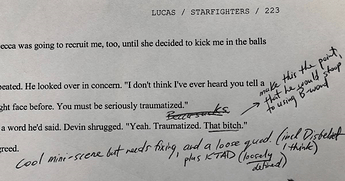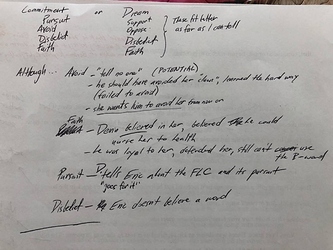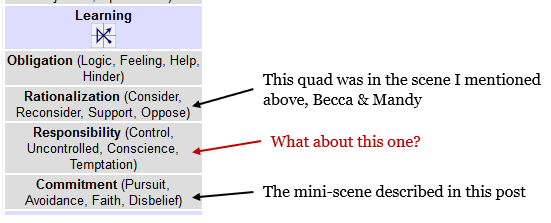I’ve been using KTAD (Situation, Attitude, Activity, Manner of Thinking) and PRCO in scene work for a while, and recently started expanding the PRCO with Justifications when necessary, as per @jhull’s recent guidance.
I thought it might be useful to show my process and some examples. There’s a lot here so I’ll save the examples for the next post(s).
One thing I find with these techniques is that, beyond the work that you do and write down to use in your scene, the most important benefit seems to be the clarity of thought. I always find the picture or understanding of my scene that exists in my head, improves further with each step. But also note that these can be overkill if you already have a great scene that feels complete, hence my step #1. 
###Scene Process
- Is the scene awesome as-is? Does it feel like it’s pretty much what I want it to be? If yes, no need for further analysis. If no, continue below…
-
First apply basic KTAD – check for Activity, M.of Thinking, Situation, Attitude. This is usually a pretty quick check. It’s rare that something is missing, but even when all four are present, it helps guide my understanding. If any are missing, make a revision note with ideas on how to include the missing item in a way that improves the scene.
-
Now do PRCO analysis. Sometimes it helps to first write some of the P,R,C,O as basic English sentences, without using Dramatica elements. Other times it helps to spot particular elements in the scene – like “ooh, this could be Inaction, and oh yeah that other thing looks like Protection”. Once I’m confident of one dynamic pair I can look at all the quads it’s a part of to find the other dynamic pair. (this step can take some trial & error)
- Knowing the elements, I assign them all to P,R,C,O and make a list of what items/beats in the scene apply. If any of the elements are missing or not conveyed strongly enough in the scene, that makes a revision note for something to fix.
-
Finally, the Justifications step. Write an Opposing Justifcations sentence for each of the P,R,C,O elements, that captures the conflict for that element within the scene. Sometimes, even though the element was present, only a one-sided justification is apparent from the scene – no competing one. What’s interesting here is that it usually seems quite natural to come up with the alternate justification that fits the scene, and this becomes a revision note for something additional to convey in the scene (even if subtextually).
Note I’ve been using this for revision lately, but for first draft it would be similar except that you might be working off ideas or a partly-written scene, so you might have more gaps to fill in.






